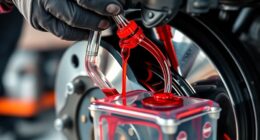To set up a car maintenance savings account, start by estimating your vehicle’s needs based on its age, make, and model. Decide on a realistic monthly contribution by breaking your overall goal into manageable steps. Automate your deposits to stay consistent, and keep some funds aside for unexpected repairs and routine maintenance like oil changes or tire rotations. If you want practical tips on establishing and maintaining this account, continue exploring how to keep your vehicle financially protected.
Key Takeaways
- Determine your vehicle’s specific maintenance needs and set a realistic savings goal accordingly.
- Open a dedicated savings account to keep maintenance funds separate from regular expenses.
- Automate monthly transfers to ensure consistent contributions without manual effort.
- Calculate the total amount needed for both routine maintenance and unexpected repairs.
- Regularly review and adjust your savings plan based on vehicle age, condition, and repair costs.

Creating a car maintenance savings account is a smart way to stay prepared for unexpected repairs and routine upkeep. When you set aside money specifically for your vehicle, you take control of your budget planning and reduce the stress that comes with sudden expenses. Instead of scrambling for funds when your car needs urgent attention, you’ll have a dedicated emergency fund ready to cover those costs. This proactive approach guarantees that your car’s maintenance doesn’t derail your finances or force you into borrowing money.
A dedicated savings account for your car keeps unexpected repairs manageable and reduces financial stress.
To get started, determine approximately how much you should save each month. Think about your car’s age, make, model, and typical maintenance needs. Older vehicles tend to require more frequent repairs, so you might want to allocate a larger portion of your budget to this fund. Establish a realistic savings goal based on these factors, and then break it down into manageable monthly contributions. Automating transfers into your dedicated account makes it easier to stay consistent and avoid the temptation to spend that money elsewhere.
Having an emergency fund specifically for your car means you’ll always be prepared for unexpected repairs, like brake replacements or engine issues, without disrupting your household finances. This way, you’re not caught off guard when something goes wrong, and you won’t have to dip into your savings or rely on high-interest loans. Instead, you can address repairs promptly, keeping your vehicle safe and reliable without added stress.
In addition to emergency repairs, your car maintenance savings account can cover routine expenses such as oil changes, tire rotations, and inspections. Planning ahead by regularly contributing helps you spread out the costs over time, making it easier to manage your budget without feeling overwhelmed when maintenance is due. It’s a smart way to keep your vehicle in top shape while maintaining financial stability.
Frequently Asked Questions
How Much Should I Initially Deposit Into the Account?
You should start by depositing enough to cover your emergency fund and your typical maintenance budget, ideally around $100 to $200. This initial amount helps you handle unexpected repairs or routine service without stress. Adjust your deposit based on your car’s age, mileage, and history. Regular contributions, even small ones, will build a solid savings cushion for future maintenance needs, keeping your car running smoothly.
What Is the Best Type of Account for Savings?
You should choose a high-yield savings account for your car maintenance fund. It offers better interest rates to help your savings grow faster. Look out for low account fees, as they can eat into your earnings. Online banks often have the best rates and minimal fees, making them ideal for saving. Regularly compare options to guarantee you’re getting the best interest and lowest fees, maximizing your savings potential.
How Often Should I Contribute to the Account?
Think of your savings account as a well-tended garden; regular watering keeps it thriving. You should contribute to your car maintenance fund at least once a month, aligning with your budget and expenses. This consistency helps build your emergency fund for unexpected repairs and keeps your investment options open for future needs. Regular contributions guarantee you’re always ready for car troubles without draining your finances.
Can I Set up Automatic Transfers?
Yes, you can set up automatic transfers for your car maintenance savings account. Doing so helps you stay consistent and guarantees you don’t forget to contribute. Many banks offer this feature, and some even provide interest rates that can grow your savings over time. By automating your transfers, you make saving effortless, and you’ll likely see your funds increase faster, making it easier to cover upcoming maintenance costs.
What Expenses Are Typically Covered by This Savings?
Sure, your car maintenance fund covers everything from emergency repairs to routine maintenance—because who doesn’t love unexpected expenses? You’ll want to save for oil changes, tire rotations, brake repairs, and any sudden breakdowns. Think of it as your financial superhero, swooping in to save the day when your car throws a tantrum. With this account, you’re prepared for the surprises that keep your vehicle running smoothly and your wallet intact.
Conclusion
Setting up a car maintenance savings account is like planting a seed that grows over time. Just as a small sapling needs consistent care to flourish, your savings will build gradually, covering unexpected repairs and routine upkeep. I once ignored this, and when my car broke down unexpectedly, the repair costs drained my finances. Starting your account now guarantees you’re prepared, turning potential stress into a manageable chapter—because a little foresight today saves a lot of trouble tomorrow.









